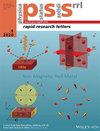关于表面活性剂辅助液相剥离水中的 MoS2 和 WS2 以实现可持续二维材料油墨的系统研究
IF 2
4区 物理与天体物理
Q3 MATERIALS SCIENCE, MULTIDISCIPLINARY
引用次数: 0
摘要
MoS2 和 WS2 因其有趣、可调的特性及其广泛的应用而备受关注。液相剥离(LPE)是制备二维 MoS2 和 WS2 的一种常见而简便的方法。目前,用于 MoS2 和 WS2 的液相剥离法的主要溶剂价格昂贵、有毒且沸点较高。这些缺点促使人们寻找更可持续的替代品来替代用于制备二维材料墨水的液体介质。水是最佳选择,但由于 MoS2 和 WS2 具有疏水性,因此在水中进行 LPE 必须使用表面活性剂。十二烷基硫酸钠(SDS)、十二烷基苯磺酸钠(SDBS)和己基磺酸钠(SHS)等具有两性特性的有机分子被选为担任表面活性剂的合适候选分子。然而,对这些用于 LPE 的表面活性剂的研究几乎没有系统的报道。在这项工作中,我们详细研究了这些表面活性剂对作为 TMDs 代表的 MoS2 和 WS2 的 LPE 的影响。通过从平均层数对产物进行表征和鉴定,我们发现所有表面活性剂都能有效地将 MoS2 和 WS2 剥离成少数层,而 SHS 比其他两种表面活性剂更能稳定二维层。然而,就产量和相对表面活性剂浓度而言,我们并没有在剥离材料数量最大化和表面活性剂浓度最小化之间找到真正的权衡,这促使我们根据具体的进一步加工需求来选择胶体墨水。本文章由计算机程序翻译,如有差异,请以英文原文为准。
Systematic investigation on the surfactant-assisted liquid phase exfoliation of MoS2 and WS2 in water for sustainable 2D material inks
MoS2 and WS2 have gathered significant attention due to their interesting and tunable properties and their wide range of applications. Liquid phase exfoliation (LPE) is a common and facile method to prepare 2D MoS2 and WS2. Currently, the principally employed solvents for LPE of MoS2 and WS2 are expensive, toxic and have high boiling points. These drawbacks encourage to find more sustainable alternatives to the liquid medium used for the preparation of 2D material inks. Water would be the best option, but surfactants are necessary for LPE in water, since MoS2 and WS2 are hydrophobic. Organic molecules with amphoteric character such as sodium dodecyl sulfate (SDS), sodium dodecylbenzene sulfonate (SDBS) and sodium hexyl sulfonate (SHS) are selected as suitable candidates for the role of surfactant. However, the study of these surfactants used in LPE is barely systematically reported. In this work, we present a detailed investigation on the impact of these surfactants on the LPE of MoS2 and WS2, which are representatives of TMDs. By characterizing and qualifying the products from average number of layers, we find that all the surfactants work efficiently to exfoliate MoS2 and WS2 into few layers, and SHS stabilizes the 2D layers better than the other two surfactants. However, in terms of yield and relative surfactant concentration, we don’t identify a real trade-off between maximized quantity of exfoliated materials and minimized surfactant concentration, which prompts to select the colloidal ink based on the specific further needs for processing.
求助全文
通过发布文献求助,成功后即可免费获取论文全文。
去求助
来源期刊

Physica Status Solidi-Rapid Research Letters
物理-材料科学:综合
CiteScore
5.20
自引率
3.60%
发文量
208
审稿时长
1.4 months
期刊介绍:
Physica status solidi (RRL) - Rapid Research Letters was designed to offer extremely fast publication times and is currently one of the fastest double peer-reviewed publication media in solid state and materials physics. Average times are 11 days from submission to first editorial decision, and 12 days from acceptance to online publication. It communicates important findings with a high degree of novelty and need for express publication, as well as other results of immediate interest to the solid-state physics and materials science community. Published Letters require approval by at least two independent reviewers.
The journal covers topics such as preparation, structure and simulation of advanced materials, theoretical and experimental investigations of the atomistic and electronic structure, optical, magnetic, superconducting, ferroelectric and other properties of solids, nanostructures and low-dimensional systems as well as device applications. Rapid Research Letters particularly invites papers from interdisciplinary and emerging new areas of research.
 求助内容:
求助内容: 应助结果提醒方式:
应助结果提醒方式:


